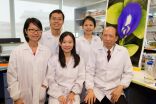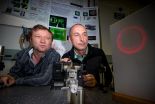(Press-News.org) How did life originate? And can scientists create life? These questions not only occupy the minds of scientists interested in the origin of life, but also researchers working with technology of the future. If we can create artificial living systems, we may not only understand the origin of life - we can also revolutionize the future of technology.
Protocells are the simplest, most primitive living systems, you can think of. The oldest ancestor of life on Earth was a protocell, and when we see, what it eventually managed to evolve into, we understand why science is so fascinated with protocells. If science can create an artificial protocell, we get a very basic ingredient for creating more advanced artificial life.
However, creating an artificial protocell is far from simple, and so far no one has managed to do that. One of the challenges is to create the information strings that can be inherited by cell offspring, including protocells. Such information strings are like modern DNA or RNA strings, and they are needed to control cell metabolism and provide the cell with instructions about how to divide.
Essential for life
If one daughter cell after a division has a slightly altered information (maybe it provides a slightly faster metabolism), they may be more fit to survive. Therefor it may be selected and an evolution has started.
Now researchers from the Center for Fundamental Living Technology (FLINT), Department of Physics, Chemistry and Pharmacy, University of Southern Denmark, describe in the journal Europhysics Letters, how they, in a virtual computer experiment, have discovered information strings with peculiar properties.
Professor and head of FLINT, Steen Rasmussen, says:
"Finding mechanisms to create information strings are essential for researchers working with artificial life."
Steen Rasmussen and his colleagues know they face two problems:
Firstly long molecular strings are decomposed in water. This means that long information strings "break" quickly in water and turn into many short strings. Thus it is very difficult to maintain a population of long strings over time.
Secondly, it is difficult to make these molecules replicate without the use of modern enzymes, whereas it is easier to make a so-called ligation. A ligation is to connect any combination of two shorter strings into a longer string, assisted by another matching longer string. Ligation is the mechanism used by the SDU-researchers.
"In our computer simulation - our virtual molecular laboratory – information strings began to replicate quickly and efficiently as expected. However, we were struck to see that the system quickly developed an equal number of short and long information strings and further that a strong pattern selection on the strings had occurred. We could see that only very specific information patterns on the strings were to be seen in the surviving strings. We were puzzled: How could such a coordinated selection of strings occur, when we knew that we had not programmed it. The explanation had to be found in the way the strings interacted with each other", explains Steen Rasmussen.
It is like society
According to Steen Rasmussen, a so-called self-organizing autocatalytic network was created in the virtual pot, into which he and his colleagues poured the ingredients for information strings.
An autocatalytic network is a network of molecules, which catalyze each other's production. Each molecule can be formed by at least one chemical reaction in the network, and each reaction can be catalyzed by at least one other molecule in the network. This process will create a network that exhibits a primitive form of metabolism and an information system that replicates itself from generation to generation.
"An autocatalytic network works like a community; each molecule is a citizen who interacts with other citizens and together they help create a society", explains Steen Rasmussen.
This autocatalytic set quickly evolved into a state where strings of all lengths existed in equal concentrations, which is not what is usually found. Further, the selected strings had strikingly similar patterns, which is also unusual.
"We might have discovered a process similar to the processes that initially sparked the first life. We of course don't know if life actually was created this way - but it could have been one of the steps. Perhaps a similar process created sufficiently high concentrations of longer information strings when the first protocell was created", explains Steen Rasmussen.
Basis for new technology
The mechanisms underlying the formation and selection of effective information strings are not only interesting for the researchers who are working to create protocells. They also have value to researchers working with tomorrow's technology, like they do at the FLINT Center.
"We seek ways to develop technology that's based on living and life-like processes. If we succeed, we will have a world where technological devices can repair themselves, develop new properties and be re-used. For example a computer made of biological materials poses very different - and less environmentally stressful - requirements for production and disposal", says Steen Rasmussen.
INFORMATION:
Ref: http://epljournal.edpsciences.org/articles/epl/abs/2014/14/epl16388/epl16388.html
Contact Professor, Head of FLINT Center, Steen Rasmussen. Email: steen@sdu.dk. Mobile: +45 60112507
The drug combination umeclidinium/vilanterol (trade name Anoro) has been approved since May 2014 for adults with chronic obstructive pulmonary disease (COPD). In an early benefit assessment pursuant to the Act on the Reform of the Market for Medicinal Products (AMNOG), the German Institute for Quality and Efficiency in Health Care (IQWiG) examined whether this drug combination offers an added benefit over the appropriate comparator therapy.
According to the findings, an added benefit is not proven: For patients with moderate COPD severity and patients with fewer than ...
Scientists at Nanyang Technological University (NTU Singapore) have discovered a new molecule which can join together chains of amino acids – the building blocks of protein.
Only three other known molecules have been discovered to be able to perform this function, which is an important process in the development of new drugs. A key difference is that the new molecule is able to do the same process 10,000 times faster than the other three and "cleanly" without leaving any residue behind.
This new molecule, which is a type of catalyst or enzyme, was derived from ...
Researchers at VTT Technical Research Centre of Finland, the University of Turku and the University of Oslo have discovered a previously unknown molecular-level mechanism that may partly explain the increased growth of cancer cells. The study, published in the British Journal of Cancer, showed that high levels of miRNA-378a-5p molecule cause cell division anomalies. This renders the number of chromosomes in cancer cells abnormal, which is known to promote growth and the spread of cancer. In addition, the researchers discovered that elevated miRNA378a-5p levels in breast ...
Laser physicists have built a tractor beam that can repel and attract objects, using a hollow laser beam that is bright around the edges and dark in its centre.
It is the first long-distance optical tractor beam and moved particles one fifth of a millimetre in diameter a distance of up to 20 centimetres, around 100 times further than previous experiments.
"Demonstration of a large scale laser beam like this is a kind of holy grail for laser physicists," said Professor Wieslaw Krolikowski, from the Research School of Physics and Engineering at The Australian National ...
What does a 1980s experimental aircraft have to do with state-of-the art quantum technology? Lots, as shown by new research from the Quantum Control Laboratory at the University of Sydney, and published in Nature Physics today.
Over several years a team of scientists has taken inspiration from aerospace research and development programs to make unusually shaped experimental aircraft fly.
"It always amazed me that the X-29, an American airplane that was designed like a dart being thrown backwards, was able to fly. Achieving this, in 1984, came through major advances ...
A pilot study testing a new type of drug in patients with chronic diarrhoea has shown promising effects on reducing their symptoms.
Bile acid diarrhoea (BAD) is a common cause of chronic diarrhoea that is estimated to affect one in 100 adults in western countries, but is often mistaken for irritable bowel syndrome (IBS) by doctors. Many patients are not diagnosed correctly and undergo repeated unnecessary tests.
The study at Imperial College London found that the drug obeticholic acid (OCA) could provide relief for patients with BAD. OCA is the first in a new class ...
Researchers at NYU Langone Medical Center conclude new drug in development may offer first alternative to standard chemotherapy for T-Cell Acute Lymphoblastic Leukemia.
Researchers at NYU Langone Medical Center and elsewhere say that blocking the action of an enzyme "switch" needed to activate tumor growth is emerging as a practical strategy for treating T-cell acute lymphoblastic leukemia.
An estimated quarter of the 500 U.S. adolescents and young adults diagnosed each year with this aggressive disease fail to respond to standard chemotherapy drugs that target cancer ...
Washington, D.C.— Hydrogen—the most abundant element in the cosmos—responds to extremes of pressure and temperature differently. Under ambient conditions hydrogen is a gaseous two-atom molecule. As confinement pressure increases, the molecules adopt different states of matter—like when water ice melts to liquid and then heats to steam. Thus far, at extreme pressures hydrogen has four known solid phases. Now scientists, including Carnegie's Alexander Goncharov, have combined hydrogen with its heavier sibling deuterium—which has an added neutron ...
This issue of Health Affairs was supported by CVS Health.
Do specialty drugs offer value that offsets their high costs?
James D. Chambers of Tufts Medical Center and coauthors conducted a cost-value review of specialty versus traditional drugs by analyzing incremental health gains associated with each. This first-of-its-kind analysis is timely because the majority of drugs now approved by the Food and Drug Administration are specialty drugs produced using advanced biotechnology and requiring special administration, monitoring, and handling—all of which result ...
Philadelphia, PA (October 20, 2014)–Promising new research in the area of hepatitis C (HCV) therapy that suggests more patients, including those with cirrhosis, will be cured from this common cause of potentially fatal viral liver disease; as well as a number of abstracts that advance understanding of the safety and effectiveness of fecal microbiota transplantation for Clostridium difficile, are among the highlights of the American College of Gastroenterology's (ACG) 79th Annual Scientific Meeting , which will be held this week in Philadelphia. More than 4,000 ...


